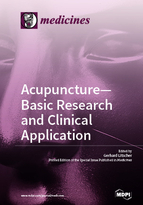Acupuncture – Basic Research and Clinical Application
A special issue of Medicines (ISSN 2305-6320).
Deadline for manuscript submissions: closed (30 April 2018) | Viewed by 80823
Special Issue Editor
Interests: photobiomodulation; laser therapy; laser acupuncture; laser medicine; evidence-based complementary medicine
Special Issues, Collections and Topics in MDPI journals
Special Issue Information
Dear Colleagues,
This Special Issue focuses on the further investigation, development, and modernization of acupuncture in basic research settings, as well as in clinical applications.
We welcome papers reporting latest evidence-based results of high-tech acupuncture research, and those exploring acupuncture in general. Studies concerning modern technology in acupuncture research are especially welcome. Manuscripts should deal with, but are not limited to, the keywords listed below.
- Modernization of acupuncture
- basic research
- traditional and modern needle acupuncture
- laser acupuncture
- electroacupuncture
- ear acupuncture
- animal experimental studies in acupuncture
- evidence-based complementary medicine
- acupuncture in clinical application and practice
Prof. Dr. Gerhard Litscher
Guest Editor
Manuscript Submission Information
Manuscripts should be submitted online at www.mdpi.com by registering and logging in to this website. Once you are registered, click here to go to the submission form. Manuscripts can be submitted until the deadline. All submissions that pass pre-check are peer-reviewed. Accepted papers will be published continuously in the journal (as soon as accepted) and will be listed together on the special issue website. Research articles, review articles as well as short communications are invited. For planned papers, a title and short abstract (about 100 words) can be sent to the Editorial Office for announcement on this website.
Submitted manuscripts should not have been published previously, nor be under consideration for publication elsewhere (except conference proceedings papers). All manuscripts are thoroughly refereed through a single-blind peer-review process. A guide for authors and other relevant information for submission of manuscripts is available on the Instructions for Authors page. Medicines is an international peer-reviewed open access monthly journal published by MDPI.
Please visit the Instructions for Authors page before submitting a manuscript. The Article Processing Charge (APC) for publication in this open access journal is 1400 CHF (Swiss Francs). Submitted papers should be well formatted and use good English. Authors may use MDPI's English editing service prior to publication or during author revisions.
Keywords
- modernization of acupuncture
- basic research
- traditional and modern needle acupuncture
- laser acupuncture
- electroacupuncture
- ear acupuncture
- animal experimental studies in acupuncture
- evidence-based complementary medicine
- acupuncture in clinical application and practice





